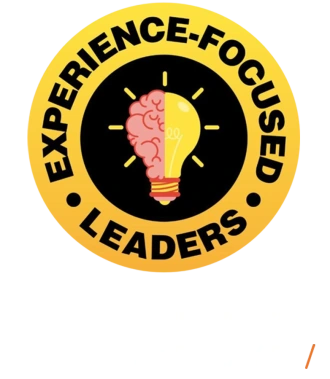Blaine is a category pioneer, an idea-stage investor and advisor, as well as an artist and inventor. He has nearly 30 years’ experience launching and commercializing innovations in the technology, media, and gaming industries.

Watch the video below
Listen to the Podcast Episode on Your Favorite Platform

Introduction to the episode
.png)
As you mentioned, I've been focused mostly on investing in what I call “idea stage companies”. I do that because I make modest investments compared to large venture capital firms. I can really make an impact on the outcome and success of a company where I feel like an advisor.
(00:01-03:04)
AS: Welcome to the Experience-Focused Leaders podcast. I am super excited to have Blaine Graboyes with us today. Blaine is an artist, inventor, founder, and, most recently, on top of all those three amazing things. He's an investor and an advisor to many other companies. And so we're very excited to have Blaine here to share a perspective of what it means to take something that's really creative. As an artist, you could tell us more about your movie, game career, the world of technology as well as other business investments.
BG: Thank you for having me, Alex! I’m glad to be able to contribute to the community that you're building. Biographically, I was born outside of Philadelphia. I went to college at a very small liberal arts school called Bennington College and very much appreciate the experience that I had there and would really say it was the defining direction that it put me in.
Since then, I've been focused on early-stage startups. I started out in the film and TV industry and co-founded the first DVD production company in New York, which certainly dates my career a bit. From there, I moved into producing video games, and I can say I've worked on games on every single platform, from consoles, PC, and mobile to Facebook and social media, to even working for about a year or two with direct TV, creating the first set-top box gaming.
Then I spent a decade in the E-sports industry, later discovered a problem in the casino gambling space, and went on to found a company where we invented the first video game gambling machines and ultimately brought that video game gambling experience online as well. A few years ago, I moved over to Europe and currently live there now.
As you mentioned, I've been focused mostly on investing in what I call “idea stage companies”. I do that because I make modest investments compared to large venture capital firms. I can really make an impact on the outcome and success of a company where I feel like an advisor.
.png)
Film, TV and the game world
.png)
The other thing that comes to mind about the crossover between film, TV, games, and startups is storytelling. For early-stage companies, it's all about the story because that's all you have. There isn't a product, market, or revenue. It's the idea, how you'll execute it, and what it will become that matters.
(03:04-11:51)
AS: That's amazing. And I think one of the things that entrepreneurs struggle with when it comes to selecting investors and who to work with is typically the unique point of view and experience that gives you an unfair competitive advantage beyond the capital. I'm really intrigued by your experience in film, TV, game world and how you are bringing that into other markets. In the customer-consumer-facing world, what do you find in the playbooks and areas of expertise that are easily transferable and we could learn from?
BG: I'm a member of the Producers Guild of America, I was the co-chair of our New York conference and a board member for a while. So it was great to interact, and I still do with some of the greatest producers in the world. One of the things that we always talk about is producing a show because everything is called a show, whether it's a film, TV, or live event, producing a show is basically the same as a startup.
Oftentimes you have to create an entity and a business plan, recruit the team, sort the funding, strategize, execute it, then market to consumers. I would say the only thing that's nicer about film and TV is that there's actually an end to it. Meanwhile, what I have learned in my startup and entrepreneur career, and something that I definitely share with companies I invest in, are the challenges with taking venture capital or any form of investment.
You are limited to only two outcomes. When you make an investment, you will either have an exit, which is the reason everybody invested, or you will have a bankruptcy, and the company will close. They are the only two outcomes that are possible because of the nature of what investors’ goals are, which is they want to get an exit and multiples on their invested capital. Creative productions, on the other hand, end up having a finish, and you can have a finish that's successful without a 10X exit.
For instance, you can have an art show expecting 1000 people, but only 100 showed up, and you felt really good about it. This is not the case for startups, the outcomes are binary. It's either a win or a loss. There's nothing in between. I think that's one of the things that's really challenging for CEOs entering the startup space.
The other thing that comes to mind about the crossover between film, TV, games, and startups is storytelling. For early-stage companies, it's all about the story because that's all you have. There isn't a product, market, or revenue. It's the idea, how you'll execute it, and what it will become that matters.
AS: There are multiple stories to your point. I think we need to be very sophisticated because there are multiple levels to storytelling. You start building things like telling the employee stories in a distributed world so that people can independently remember.
BG: I find the relationship between entertainment and entrepreneurism really interesting. For example, when you're doing a show, you're working on it for days, months, years. But when you finish, and I find a lot of my peers find that it's not uncommon to get quite depressed. Even if it's been a success, you've been working on it for so long, and now it's definitely done.
And as I talk to startup entrepreneurs and have been one myself, “You're working so hard for your fundraising, you're putting everything into it, you're flying back and forth, you're pitching and building your team, you're really investing your life into raising this money, and it would seem that money would be elation. It would be the happiest day of your life.” It's sort of depressing because you've been working on something, and now it's done, and maybe it could have been better or worse, it doesn't matter. It's done, and you're not able to invest your energy and belief into that part of it anymore. You're moving it into another, and it's like the show is over.
AS: That's interesting. I think if I read between the lines, the answer is we should all be thinking like a Marvel Cinematic Universe, think of a never-ending franchise.
.png)

Solving the problem you're setting out to solve
.png)
The point is you need to tell a story that people can easily repeat. I think the few-as-best approach applies to almost everything. I basically wear the same thing every day. I'm very simple in my personal life and habits. I'd rather have something high quality or nothing. I'd rather work with a small team than a big team. I'd rather do one thing that's amazing than 10 things that are modest. And I think that's a way that people can really approach startups, it’s a bit subjective, but people can actually apply it in their business and personal lives.
(11:51-22:55)
BG: I think that's one way to think about an entrepreneur's journey. I think a big thing that needs to be considered in the early stage of a company is solving the problem you're setting out to solve. You're setting out to solve a problem that you want to invest many years in, and certainly raising outside capital is one way to do it. There's debt and equity, and there are ways to do it; through revenue generation, operations, and partnership. Basically, raising capital isn't always the answer, and often, it's not the right answer.
AS: Absolutely. We at this podcast support audiences from enterprises to entrepreneurs who want to create amazing customer and employee experiences for their stakeholders in general. You can't spend or invest in experiences that are not scalable and repeatable. How can you create maximum value, experience, and special moments for your key stakeholders? Because the market is changing, the expectations are changing, the product is changing, and customer needs are also evolving. You know, everybody's not like you, you figure out the best enterprise platform, and now that AI is coming in and disrupting you, so you’d need to adapt to that.
One of our ambitions is to do what would change the course of human history, maybe in a minor way, doing something that would be better for society as a whole. We, at RELAYTO, for example, are very fortunate to work on reimagining storytelling, which is very fundamental to the progress of civilization. So, in your experience across different businesses that you have worked with, what have you seen successful teams do to reach beyond that ending point?
BG: I love the idea of thinking bigger. There are many things to talk about, but one that just immediately jumps to mind is “the less is more” approach. And an example that I can give that's very personal is I recently launched a coffee company with a business partner and two other partners. My partner had been working on the wholesale side of it. And her partner and their family have been working with family farmers in Uganda since 1955. They organized the first family farm collective in Uganda in 1955. And to this day, the families of those farmers still farm on the same land in Uganda, and they needed to find a strategy to release their product to retail in the United States.
I felt like we could really contribute to that. So I ultimately became a founder and an investor in the business. We launched about a month ago. And our mission is a big mission, which is, we give 50% of the profits back to the farmers from the retail sale. That's a really big idea. It's gonna take a long time until the promise of that locally has an impact because the money goes to things like planting trees. Having the shade from trees is important to grow the crops and it keeps the soil strong so that it doesn't get washed away from erosion. But the idea that we could work with farmers who have been doing this since 1955 and are trying to find a path into the US market is very interesting.
We believe we can change the business model from lowball to a wholesale level. Originally, we wanted to buy the product as inexpensively as possible so that we could make the most money possible, instead, there's a new model. We could buy the beans at market rate and then share half the profit with the farmers from retail, and now we've created a supply chain where everyone shares the benefit that comes out of that. And I think that's a great example.
When I'm thinking about the “few-as-best” approach, an example is I put together the website, and we had tons of material. Again, they've been doing this for almost 70 years with the farmers. There are dozens of pages of text, blogs, videos, and photos that they've created and have only been wholesaling for five years at the end of the day. If you go to our website, we've distilled it down to four photos and four tiny paragraphs that are two sentences each. And I think if you scroll down our page, it tells a really strong story.
The point is you need to tell a story that people can easily repeat. I think the few-as-best approach applies to almost everything. I basically wear the same thing every day. I'm very simple in my personal life and habits. I'd rather have something high quality or nothing. I'd rather work with a small team than a big team. I'd rather do one thing that's amazing than 10 things that are modest. And I think that's a way that people can really approach startups, it’s a bit subjective, but people can actually apply it in their business and personal lives.
AS: This reminds me of the quote, “Perfection is not when you can't add anything, but when you can't take anything away”. It's like saying, “Let's create more with AI, we can do more. We could turn out 10,000 pages of garbage versus 1000 pages or send out 10,000 spam emails, but what you're saying is that the experiential and storytelling that kind of touches humans is about distilling it to its essence.
BG: I’ll give ‘“perfection” a high bar. I'm happy with “best”. I believe “best” is a really good target. I think for most startups, there's a lot more luck than perfection that will be involved. Another way to look at it, let's say, from the engineering or the product mindset is the most expensive feature is the one you didn't need. I often see startups, and they're like, “We have to make XYZ”, but at the end of the day, two of them are actually meaningful and going to be used by people today. The rest is wasted money, time, and effort. So the features you don't need are the biggest waste of time, money, and effort possible in a business. There are different ways to figure out the ones you do need and don't need, but certainly, building the ones you don't need is a very wasteful use of resources.
.png)
Maximizers and satisfiers
(22:55-29:12)
AS: You added this dimension of perfection, like perfection versus the best. There is a lot of research on this, both in terms of human performance and satisfaction with life. There are maximizers and satisfiers. So the maximizers would be seeking the perfect decision. They will be doing a lot of research and optimization, burning the midnight oil, and making sure they get to perfection. Then the satisfiers are quickly making decisions that are good enough and are moving on to see if they worked.
If we consider startups or any rapidly moving organization, there's a risk of taking too long to make a decision, especially if it's reversible. If you make an irreversible decision then you might need to be more of a maximizer. Although, the majority of decisions are more iterative. So what's your take on that? And then how does this fit into your framework and experience, especially in the creative form? I would love to hear that perspective and whether you see similar parallels.
BG: I've never heard of the maximizer or satisfier. I don't know if those words resonate with me, but I guess I would say that the technique I have arrived at is intuition and analysis. I'm a pretty big believer, from a philosophy of science and neuroscience perspective, that we have no idea why we make decisions. There's no school of thought or scientific research that says this is exactly how humans make decisions. But for me, I think a big part of it is intuition, and analyzing is the most important part.
If you follow your intuition and creativity, you will arrive somewhere. But if it's in business, you would need to have an idea. But then I think you need to quickly analyze. And when I say analyze, I do not mean forever to make the perfect decision. I mean, get in the ballpark or open up a spreadsheet. The easiest one that I always point out is revenue models. An example is CRE; super creative and magical if you can quickly analyze it. I think it's important, particularly for CEOs, that you can do both of these things: you can make a visually compelling PowerPoint or presentation, open up a spreadsheet, and do some basic calculations.
The good thing is that's where you get into a positive iterative cycle. “I have an idea, but when I analyze it it doesn't work. Why doesn't it work? Oh, it's this one bit here that doesn't work. How could I solve that? Oh, if I just changed my idea a little bit, I could change the formula of how that's working.”
You commit to everything in life, could be an investment, a startup, a relationship, or just hanging out at the restaurant. All of these things that you commit to have the opportunity to blow up into a lot more than you were expecting them to be at some point.
.png)

On storytelling
.png)
What I always say is, in five minutes or less, I have to get it all and have to be like 90% correct in my understanding and interpretation of it. Whether that means photos, icons, or graphics, the content is the content. Being able to package it in a way that is engaging, fun, and easy to download. I think the single most important asset of a business is its pitch stack of 5 to 10 slides. When pitching, whether you're fundraising, telling the story to a bank to get a loan, or your parents so they can be proud of you, you've got to be able to send someone a PDF that they can open immediately.
(29:12-43:00)
AS: That's really interesting. We often think of an experience as remarkable and something that you just want to tell the rest of the world about. But there's also the negative experience. There's something that's probably quite achievable but not incredibly remarkable, it still creates positive associations. I call it a “frictionless experience” where you get something done, and you don't notice that it requires any mental capacity or cognitive processing to do it, and then you only notice it when you don't have it.
For example, at RELAYTO, we started transforming PDFs and saw customers’ responses. You have a longer career horizon than most, what have you seen in the storytelling quality? Is it improving in startups and in businesses as a whole?
BG: Yeah, quality has improved in every aspect, particularly in tech businesses and startups across the board. There are so many platforms, tools, frameworks, and documentation out there that would have taken ages five years ago, but now you could mock-up or build it in a day. One that resonates with me is my experience in PDFs or decks for an early-stage startup. I think your deck is the single most important asset of the business. It probably needs to be updated many times, including after funding, you would want to update it multiple times so that any time anyone asks you to tell them about the business, you can just send them the deck.
What I always say is, in five minutes or less, I have to get it all and have to be like 90% correct in my understanding and interpretation of it. Whether that means photos, icons, or graphics, the content is the content. Being able to package it in a way that is engaging, fun, and easy to download. I think the single most important asset of a business is its pitch stack of 5 to 10 slides. When pitching, whether you're fundraising, telling the story to a bank to get a loan, or your parents so they can be proud of you, you've got to be able to send someone a PDF that they can open immediately.
That is a really great experience for them. At the end of the day, it boils down to making these content experiences perform their job. To me, the pitch deck is the culmination of those things.
AS: You are talking about the feedback loop, right? Like you're basically saying something that I think oftentimes gets forgotten by people that are in a creative space. The majority of the people in the creator economy don't succeed because nobody wants to consume whatever they're creating, so they're having fun expressing themselves, which is rewarding. Although it doesn't lead to some economic or productive activity.
I think when we shift to the business world, storytelling has a purpose, it needs to accomplish something. The feedback loop is the culmination of what differentiates outcomes from creativity. I wonder if you've seen that loop tighten a bit more in various industries. I would imagine that is the core part of E-gaming, but what about other industries?
BG: The core of Art School is criticism. It's called Crit. For instance, you do a bunch of work and try to explain it to your professors and classmates, and in real-time they would tell you what they think. I don't think there is a faster and better feedback loop than Art Crit. When it comes to technology, I think one of the challenges is getting feedback which would be useless if you're not going to listen to it. I don't mean listening to it in a quantitative, qualitative, or analytical way, I mean really understanding the reasons for it.
For startups, the core of your pitch deck is your problem statement and solution statement. What’s really dawned on me over the last two years is that the problem statement isn't actually the important part. It's the reasons and causes of the problem that are the important part. Then that's what your solution statement is all about. If you solve those causes and reasons, that would be your successful product because people would definitely pay for it. It's easy to lose track of the solution side of it, of not focusing back on those reasons and causes, and instead, you're just making something that's great. It's a perfect product, and you're getting feedback, you could even be making money and solving aspects of your problem, but you're not actually solving the reasons for the problem in the first place.
AS: That's a beautiful way of thinking about it. One of our customers uses our product because it gives them an extra bit of confidence when presenting.
BG: Not to psychoanalyze your client, but it sounds like they're needing confidence, which is fair. It's hard to present in front of people. That's the reason for their problem, and now they've articulated it back to you.
AS: Well, I think you connected the dots. I really appreciate it. It's like the root cause is more important than the problem.
BG: It's interesting that you say “root”. The questions you should ask are, “What's the root cause? Why did this actually happen?” If you have to go down to the molecular level to know that root cause, I think that is absolutely the takeaway. And again, your example is the best one, right? It wasn't that they wanted fancy presentations. The root cause was they wanted to be more confident..png)
Final thoughts
(43:00-44:01)
AS: Well, this is great. You're helping me understand your experience, and hopefully, this is really helpful to our audience. I can't thank you enough for taking the time to walk through and share some of your experiences with us. Where can our audience find and connect with you
BG: Sure, the easiest way is Blaineglobal.com.
AS: Thank you so much. What a fun conversation. What a broad range and just really exciting for the companies and causes you're supporting; you're bringing a wealth of experience across so many dimensions to them. Thank you again for sharing your time and expertise with us.
BG: Thank you, Alex. I really appreciate it.
Other Episodes

Godard Abel | CEO of G2
S 01 | Ep 6 Where You Go for Software: Reach Your Peak


Dean Stocker | CEO of Alteryx
S 01 | Ep 8 Turning Your Customers Into Your Biggest Champions


Peter Fader | Co-Founder of ThetaCLV
S 01 | Ep 10 Turning Your Marketing Into Dollars

Author

Experience-focused Leaders is the #1 Multimedia Podcast! We talk to senior business & tech leaders about the experiences that move forward organizations, customers and society at large. True to form, we mix audio, video, web and eBook formats to turn these authentic conversations into personalized nuggets you'll remember & use.



.png)

.svg.png)

